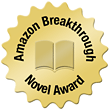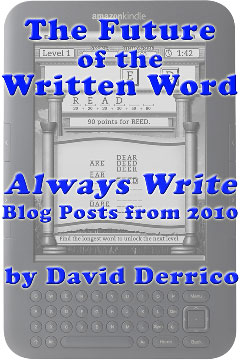
You didn't really think they could just get along, did you?
It was only a matter of time.
Once Apple entered the e-book business back in April with the launch of the iPad and the iBook Store — and partnered with publishers to cram the agency pricing model down Amazon’s throat — a collision like this was probably inevitable. After all, Apple has been selling e-books to be read on iDevices through the iBook store, while Amazon has been selling e-books for those same iDevices through the Kindle for iPhone/iPad apps. And, it’s pretty clear which of those two e-book retailers has been more successful: Amazon still commands the strong majority of e-book sales, while Apple’s iBook Store has floundered. So, is Apple OK with Amazon moving in and selling all those e-books to iDevice owners?
Apparently not. In the past week, Apple has started “clarifying” its position on e-book stores (and magazine and newspaper publishers) selling content through iOS apps to (what Apple sees as) Apple’s customers. The first salvo was when Apple denied the Sony E-Reader app, claiming that it violated guidelines related to in-app purchases. Over the ensuing week, Apple’s position became more clear, as it is apparently gearing up to require vendors who sell content to do so through in-app purchases. At issue is the current practice of many current apps (like Kindle for iPhone) that take users to Safari to purchase e-books over the Internet, bypassing Apple’s app store and its 30% cut of all app and in-app purchase proceeds. And Apple has given existing apps until June 30 to comply with the new requirement, which is that any app offering out-of-app purchases (like those over the Internet), must also offer an in-app option (at the same price). Of course, the in-app option (which will just be a click, attached to your existing Apple account and payment method) will be much more convenient for most users than launching a website and signing in. (Crazy side-note: Apple licenses Amazon’s patented 1-Click purchasing system.) Even worse, it appears from Apple’s latest statements that apps can’t even link to outside stores (like Amazon), but only offer the in-app purchase!
“Our philosophy is simple — when Apple brings a new subscriber to the app, Apple earns a 30% share,” said CEO Steve Jobs in a statement Tuesday. “When the publisher brings an existing or new subscriber to the app, the publisher keeps 100% and Apple earns nothing.”
“Apple does require that if a publisher chooses to sell a digital subscription separately outside of the app, that same subscription offer must be made available, at the same price or less, to customers who wish to subscribe from within the app.”
Think about that for a minute: Apple will now require e-book vendors (Amazon, B&N, Sony), magazine publishers, streaming video apps, and anyone else who sells anything that can be accessed through an App Store app to remove external Internet “buy links” and instead offer an in-app purchase option. And Apple will get 30% of all of those sales. In the case of e-books, the agency model agreements already specify that e-book retailers only get 30% of the sale price, which means that Apple would get all of the profit (and then some, since Amazon has some costs) from e-book sales: 70% would go to publishers, and 30% to Apple, with Amazon getting nothing. And while it currently appears that customers could choose to bypass the one-click in-app purchase and buy directly from Amazon’s website instead (from their computer, or by going to Safari themselves), how many will? And what is to stop Apple from preventing external purchases from being usable inside an app?
Obviously, Amazon can’t let this stand. There’s no way they’re going to agree to create the world’s largest e-book store, write an iOS app, deliver e-books to customers, and provide tech support for purchases, yet give all the revenue from Kindle app users to Apple. But, Amazon has promoted the “Buy Once, Read Anywhere” tagline, as it lets users read e-books purchased from the Kindle Store on Kindles, Macs, PCs, smartphones, Android, and Apple iOS devices. Yes, pulling the Kindle for iPad app would hurt Apple and the iPad’s already-damaged reputation as an “e-reader” and would tick off customers who bought an iPad thinking they could unify their Amazon, B&N, Sony, Kobo, and Apple e-book libraries on one device, but it would also tick off Amazon customers and Kindle owners who like to read from time to time on their iPhones. It’s pretty much a lose-lose situation, but Apple seems to be forcing the issue.
What’s the upshot of all this for iDevice owners? Will their iPhones and iPads become less useful overnight? I think being able to access Kindle e-books on the iPad was an important selling feature for Apple. How much other content will iDevice users lose access to? What other apps will this new policy affect? Would you want to develop an iOS app right now?
Even more disturbing are the future ramifications of such a move by Apple. If Apple considers iOS users as its customers for third-party goods (in a way that Dell, for example, never does when you use one of their computers to buy something online), what else will they try to “tax”? Now that Apple has earned a dominant position in the mobile app field (the Apple App Store is far ahead of the Android Marketplace or any competitors), how long until it starts changing the terms on developers? Although those developers provided a large portion of the value of Apple’s “platform” (the iDevice + wide variety of cool apps in the App Store) and helped make it #1, now that Apple is the dominant smartphone and tablet computer platform, it doesn’t need any one developer nearly as much as that developer needs Apple. What’s Apple’s next move here? Perhaps requiring exclusivity from its apps to prevent Android from becoming a threat?
This new Apple policy is a pretty disturbing move (that is almost certain to hurt consumers, however it shakes out), but even more disturbing is how Apple has morphed from the plucky underdog to the ruthless, monopolistic giant corporation that uses its power to squash competition. To complete the irony, perhaps the best hope to tame the Apple juggernaut is a partnership between Nokia and a plucky upstart in the mobile operating system field: Microsoft.










